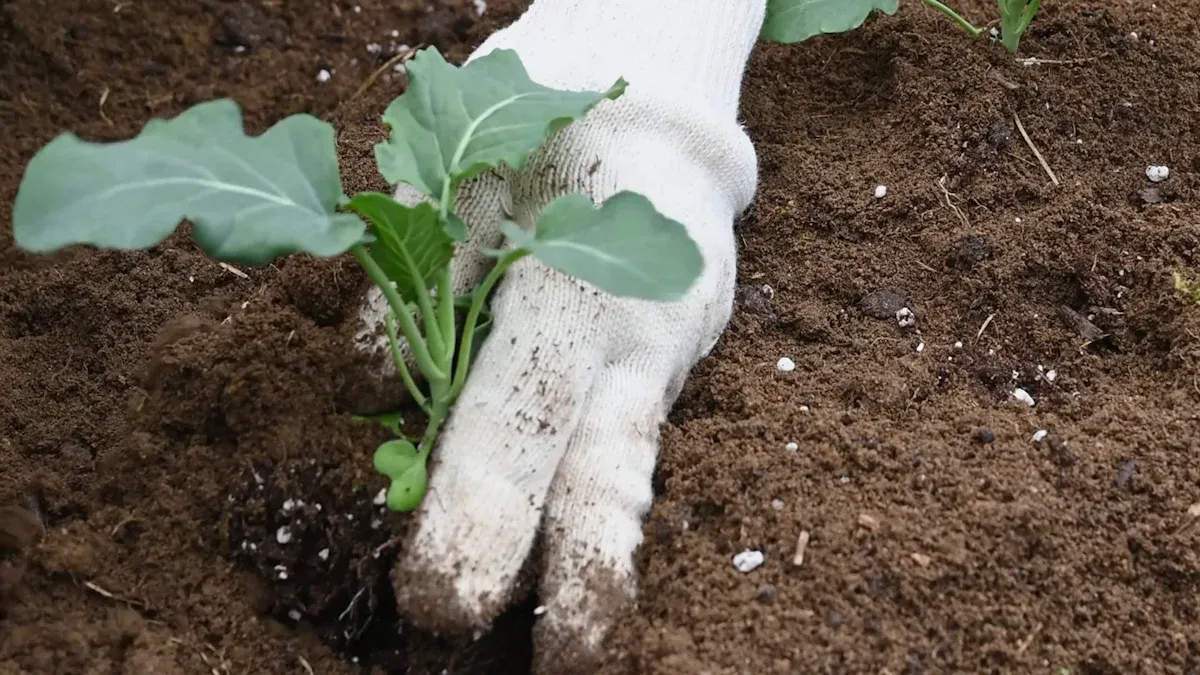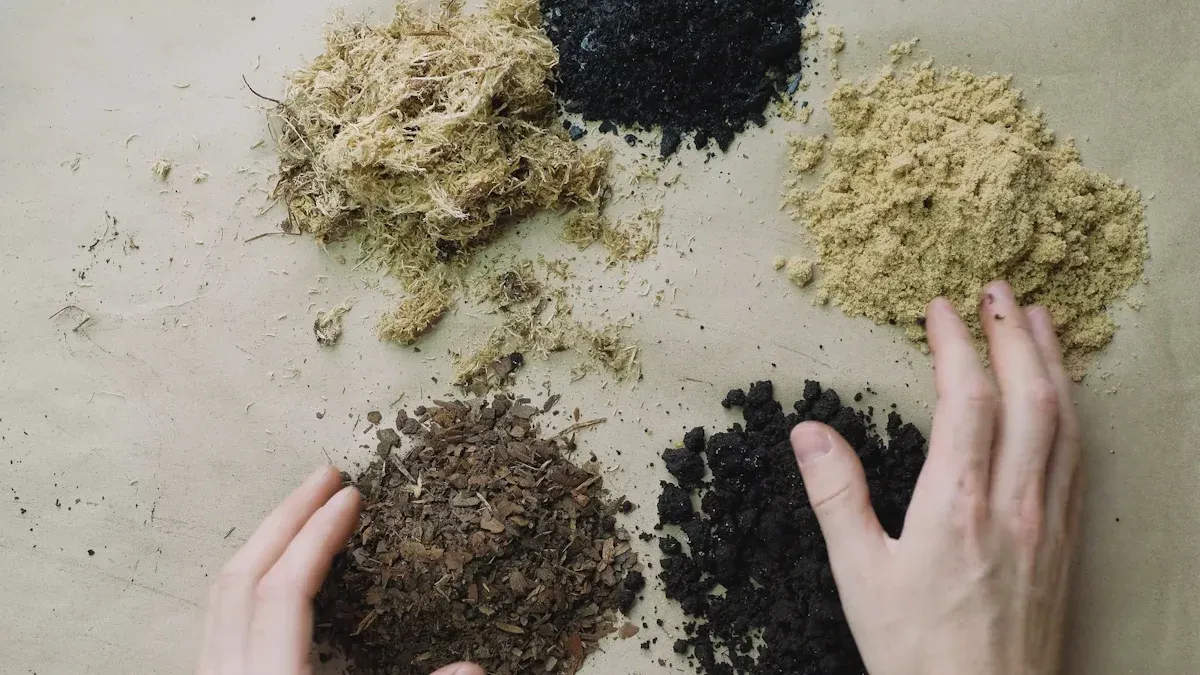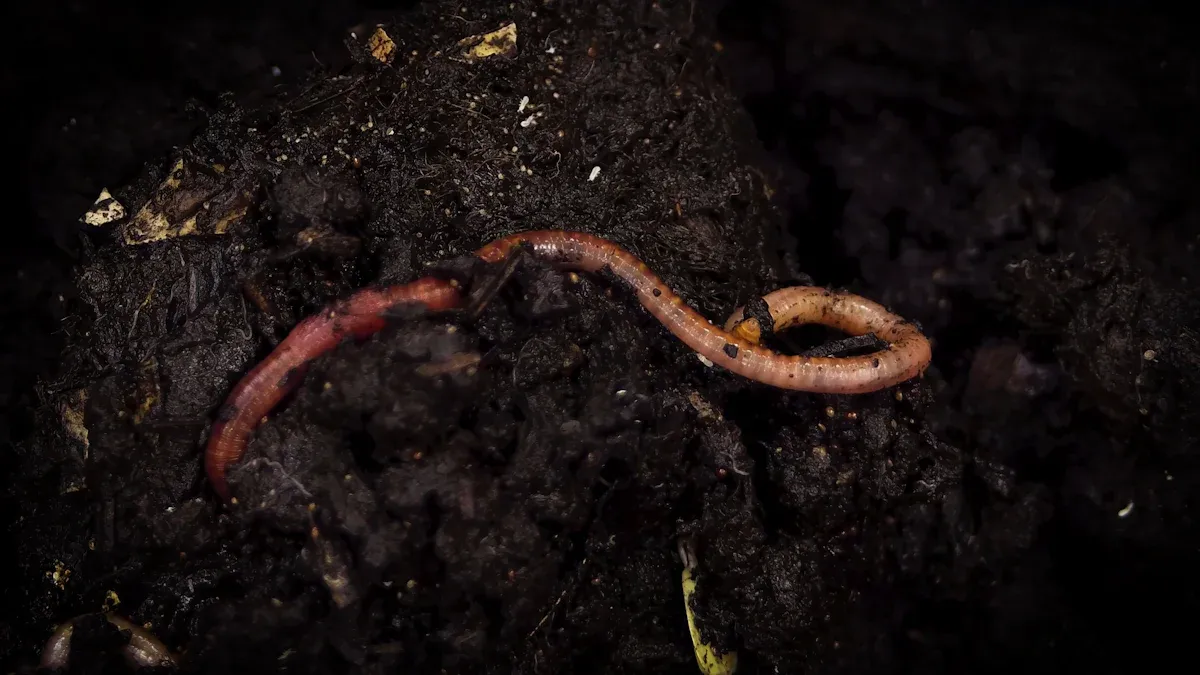
Amending clay soil is crucial for your gardening success. Many gardeners face challenges with clay soil, including:
It hardens when dry and becomes sticky when wet.
Water is tightly held, making it hard for plants to access.
Compaction makes it tough for roots to grow.
Poor drainage limits air access to plant roots.
Using essential amendments can help you overcome these issues and create a thriving garden.
Key Takeaways
Adding organic matter, like compost, improves clay soil structure and nutrient availability, leading to healthier plants.
Gypsum enhances drainage in compacted clay soil, making it easier for water to flow and roots to grow.
Regular aeration techniques, such as using cover crops or broadforks, prevent compaction and promote better oxygen access for roots.
Incorporating materials like grass clippings and wood chips can further enhance soil health and moisture retention.
Consistent care and amendments over time yield the best results, transforming clay soil into a thriving garden environment.
Essential Amendments

When it comes to improving clay soil, essential amendments play a vital role. Among these, organic matter stands out as a key player. Let’s dive into the benefits of organic matter and how you can effectively incorporate compost into your gardening routine.
Organic Matter Benefits
Adding organic matter to your clay soil can transform its structure and overall health. Here are some of the benefits you can expect:
Improved Soil Structure: Organic matter helps break up compacted clay, creating a more crumbly texture. This change allows roots to penetrate more easily, promoting healthier plant growth.
Enhanced Water Retention: Organic matter acts like a sponge, holding onto moisture and making it available to plants. This is especially important in clay soil, which can struggle with drainage.
Increased Nutrient Availability: As organic matter decomposes, it releases essential nutrients that plants need to thrive. This process boosts the fertility of your soil, reducing the need for chemical fertilizers.
A significant increase in soil macroporosity was observed with a large one-time addition of organic soil amendments, showing an average increase of 20–27% compared to control samples. This enhancement in macroporosity improves soil aeration and water infiltration, which are crucial for managing clay soil effectively.
Incorporating Compost
Now that you understand the benefits of organic matter, let’s talk about incorporating compost into your clay soil. Compost is a fantastic way to add organic matter, and here’s how you can do it effectively:
Choose Quality Compost: Look for compost that is dark, crumbly, and free of contaminants. High-quality compost will provide the best results for your soil.
Mix It In: Spread a layer of compost over your garden bed and mix it into the top 6-12 inches of soil. This will help improve soil structure and nutrient content.
Frequency Matters: Regularly adding compost can lead to long-term improvements in soil fertility. Studies show that compost can increase soil organic carbon by up to 124%, significantly enhancing soil aggregates.
Treatment | Increase in Soil Organic C (%) | Effect on Aggregates |
|---|---|---|
Compost (CM) | 124% | Increased macroaggregates |
Compost (HCM) | 72% | Increased macroaggregates |
Mineral Fertilizers | <27% | Lesser effect on aggregation |
By incorporating compost into your clay soil, you not only improve its structure but also create a thriving environment for beneficial microorganisms. These tiny helpers aid in nutrient cycling and disease suppression, making your garden more resilient.
Gypsum for Drainage

If you’re struggling with compacted clay soil, gypsum can be a game-changer. This natural mineral helps improve drainage by replacing sodium ions with calcium. This process enhances soil structure, making it less compacted and easier for water to flow through. Here’s how gypsum works its magic:
Enhances Drainage: Gypsum specifically improves drainage in sodic soils. It helps break down the compacted clay, allowing water to move more freely.
Reduces Compaction: By improving soil structure, gypsum makes it easier for roots to grow and access nutrients.
When applying gypsum, you want to make sure you do it right. Here are some effective application methods:
General Use: For most residential gardens, apply 0.5 to 1 ton of gypsum per hectare, which translates to about 500 grams per square meter.
Heavy Clay Soils: If your soil is particularly heavy, you might need up to 5 tons per hectare or about 2 kg per square meter.
Small Areas/Gardens: For smaller spaces, just use 2-3 handfuls of gypsum.
Frequency: You should apply gypsum annually for several years to see the best results.
Application Type | Rate (per hectare) | Rate (per square meter) |
|---|---|---|
General Use | 0.5 to 1 ton | 500 grams |
Heavy Clay Soils | Up to 5 tons | 2 kg |
Small Areas/Gardens | N/A | 2-3 handfuls |
Frequency of Application | Annually for several years | N/A |
You might wonder how long it takes to see improvements after applying gypsum. While you may notice some changes in workability and drainage within the first growing season, significant improvements usually require consistent organic matter additions over 2-3 years.
By incorporating gypsum into your gardening routine, you can create a healthier environment for your plants. With better drainage and reduced compaction, your clay soil will become more manageable, leading to a thriving garden.
Gardening in Clay Soil
Gardening in clay soil can be challenging, but with the right strategies, you can create a thriving garden. Here are some practical tips to help you manage your heavy clay soil effectively:
Add Organic Matter: Spread a 2- to 4-inch layer of organic matter annually, ideally in the fall. This improves soil structure and nutrient availability.
Use Mulch: Organic mulch protects the soil from compaction and moisture loss. It keeps the soil loose and fertile, which is essential for healthy plant growth.
Aerate Regularly: Aeration is crucial for preventing compaction and improving oxygen availability for plant roots. You can use several techniques to aerate your clay soil:
Cover Crops: Planting green cover crops like winter rye, alfalfa, and clover helps loosen compacted clay soil and adds organic matter.
Broadfork: This tool is effective for breaking up soil compaction without damaging the soil structure, allowing air and water to penetrate.
Bio-Drillers: Plants such as daikon or tillage radishes create channels in the soil with their deep taproots, improving aeration when they decompose.
Using these aeration techniques not only improves soil structure but also enhances nutrient availability. For instance, properly amending clay soil can significantly boost nitrogen levels, which is crucial for plant growth.
Regular aeration has a positive impact on root development. Studies show that it enhances root morphology, increasing root length, surface area, and volume in clay loam soil. Increased oxygen content from aeration promotes root metabolism and nutrient absorption, leading to improved overall plant growth.
Importance of Drainage
Good drainage is vital for gardening in clay soil. Here are some effective drainage solutions:
Add Organic Compost: This improves soil structure and water movement.
Use Bark Mulch: It reduces compaction and adds organic matter.
Apply Gypsum: This helps break up compacted clay soil.
Aerate Clay Soils: Create channels for better drainage.
Avoid Walking on Wet Soil: This prevents further compaction.
Build Raised Beds: They enhance drainage and soil quality.
You can also change drainage patterns to prevent water ponding. Building raised beds or berms creates well-drained planting areas. Additionally, creating a swale can help move water away from the planting area, ensuring your plants thrive.
By implementing these strategies, you can significantly improve clay soil conditions. With better aeration and drainage, your garden will flourish, leading to healthier plants and increased yields.
Additional Materials
When it comes to improving clay soil, you have several additional materials at your disposal. These can help enhance soil structure and drainage, making your gardening experience much more enjoyable. Here’s a list of some effective options:
Compost: This is a fantastic way to add organic matter and nutrients to your soil.
Grass Clippings: They break down quickly and provide nitrogen, which is essential for plant growth.
Wood Chips: These help retain moisture and improve soil aeration as they decompose.
Manure: Well-rotted manure adds nutrients and improves soil texture.
While these materials can be beneficial, you should be cautious when adding sand to clay soil. If you add sand without sufficient organic matter, you might create a denser soil structure. The clay particles can fill the spaces between the sand particles, leading to a binding effect similar to concrete. This can severely hinder drainage, which is the opposite of what you want.
On the other hand, gravel can significantly improve drainage in heavy clay soils. Here’s how gravel contributes to soil health:
Gravel is highly durable and well-draining, making it suitable for enhancing drainage.
Its resistance to erosion means that gravel maintains its structure and drainage capacity over time.
When compacted, gravel provides a stable foundation, which can enhance the overall drainage performance of the soil.
To improve soil texture without causing compaction issues, aim to incorporate sand only if you can add at least 50% sand by volume. This ratio is crucial because small amounts of sand can lead to a concrete-like mixture, which is detrimental to soil health.
Incorporating these materials into your clay soil can lead to long-term benefits. A study showed that repeated applications of compost significantly enhance soil carbon and microbial biomass. Over time, these amendments can lead to sustained improvements in soil health, particularly in terms of microbial diversity and activity.
Improving your clay soil is essential for achieving healthy plant growth. By adding organic matter, gypsum, and other materials, you enhance soil structure, drainage, and nutrient availability. These changes lead to better root growth and increased microbial life, which supports nutrient cycling. Remember, noticeable improvements take time. You might see changes within 4 to 6 weeks after applying amendments, but consistent care will yield the best results. So, assess your clay soil today and start your journey toward a thriving garden!
FAQ
What is clay soil?
Clay soil consists of very fine particles that compact tightly. It retains moisture well but drains poorly. This can make gardening challenging, as plants may struggle to access water and nutrients.
How can I tell if I have clay soil?
You can test your soil by taking a handful, adding water, and forming a ball. If it holds its shape and feels sticky, you likely have clay soil.
How often should I amend my clay soil?
You should amend your clay soil at least once a year. Adding organic matter, like compost, regularly improves soil structure and nutrient availability over time.
Can I plant directly in clay soil?
Yes, you can plant directly in clay soil, but it’s best to amend it first. Adding organic matter and improving drainage will help your plants thrive.
What plants grow well in clay soil?
Many plants tolerate clay soil, including daylilies, black-eyed Susans, and certain types of grasses. Choose native plants, as they often adapt better to local soil conditions.

